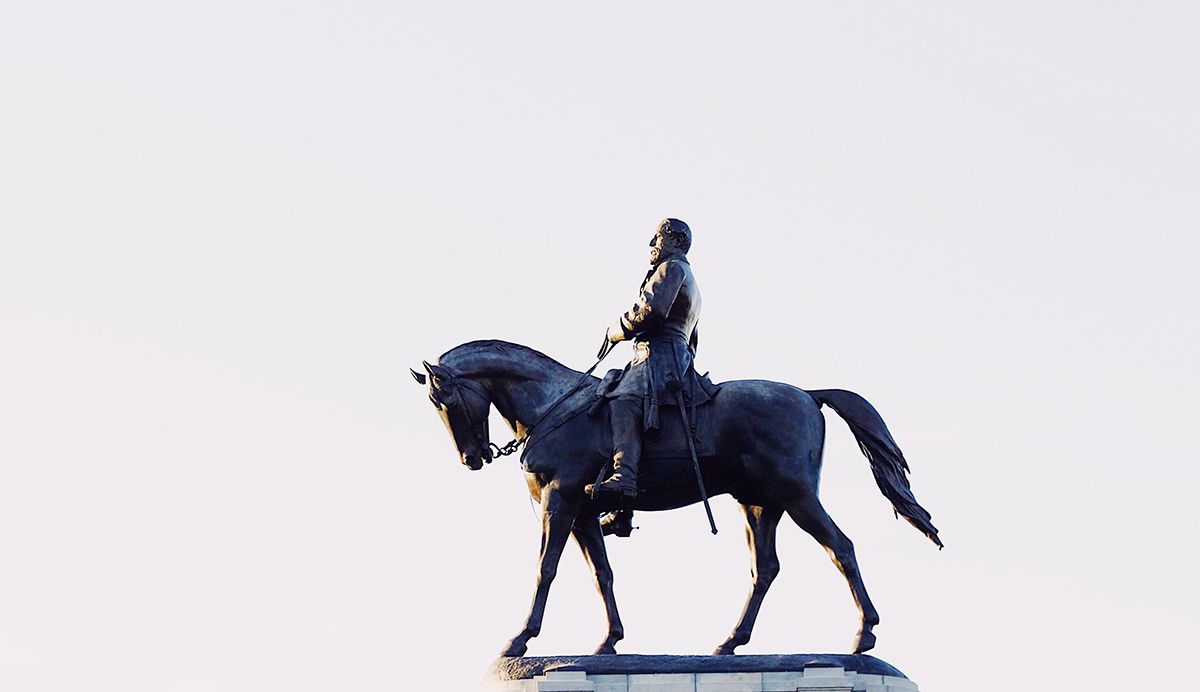The growing recognition that monuments to white men who supported oppression have no place in our public spaces has been a long time coming. It took a new generation of activists aroused by the public execution of George Floyd and the Black Lives Matter Movement to affect change. We've witnessed predominantly young protesters of every description fighting for justice and equality. The protesters have identified these public monuments as symbols of racial repression and took action by removing them.
I support the protesters' use of force in removing public installations which they identified as symbols of racial injustice. These racist tributes and narratives had been maintained at taxpayer expense for decades and longer. Yet, there has been no concerted effort by public officials in many jurisdictions to effect their removal.

The nation has been captivated by the scope and breadth of the George Floyd protests which dwarf all previous grassroots political movements. The collective judgment of these protesters matters, but some of their methods for being heard have been controversial, including their broad condemnation of historic monuments and an an array of historic persons. Though I believe the protesters have gotten it right for the most part, they wield a blunt instrument.
Not surprisingly, President Trump once again chimed in to condemn the removal of Confederate monuments while vilifying the protesters. He appears oblivious to the moral force of this protest movement, and thinks it galvanizes his base to threaten prosecution and long prison terms for the protesters, labeling them as Marxists, anarchists, and looters while defending the Confederacy and its leaders — men who took up arms against this republic. Unfortunately, these views are held by far too many.

In my formative years, I recall my first visit to Washington, DC. I toured the Capitol building and the hall of statues, and I wondered why in addition to the heroes, the hall contained tributes to Confederate military and political leaders. Here in the halls of Congress, the defenders of slavery are enshrined. Why this mixed messaging? What did their presence say about how I'm viewed as an African American? I recall my unease.
Over time, the public has grown accustomed to these political relics and has become numb to the hypocrisy of the public display of tributes to men whose notoriety stems from rebellion, war, and the tyranny of the antebellum south. For many Americans, these symbols have always been troubling. If the protesters hadn't taken action and provoked a long-overdue reckoning, who would have taken the initiative and when?
I find Confederate war monuments to be particularly objectionable. They amount to a public apology for defending the union and waging war against slavery. Many Americans seem to have forgotten that the Confederates were traitors to the United States. Their act of secession led to 215,000 deaths on the battlefield and polarized the civilian population for generations.
Trump's statements supporting these Confederate tributes are all the more loathsome because he is once again sending a message to Americans that there were "good people on both sides" and that the "good people" who fought to defend the institution of slavery were somehow justified.
Despite Trump’s hostile opposition, the multitudes of Black Lives Matter protesters reinforce the inescapable conclusion that it is morally wrong to permit monuments with racist connotations to remain as permanent fixtures in our civic landscape. This protest-driven campaign to cleanse our public venues of racist symbols has been questioned by others. This was inevitable because there isn't a consensus on what monuments warrant removal and which do not.
The Bay Area finds itself in the midst of this controversy. The justification for the removal by protestors of monuments celebrating Father Junipero Sera and President Ulysses Grant, as well as the defacement of a bust honoring Judge Donald McCollum, have been sources of division.
Activists just toppled the Junipero Serra statue in Golden Gate Park here in San Francisco
— Joe Rivano Barros (@jrivanob) June 20, 2020
Now they’re onto Francis Scott Key, slave owner and writer of the Star Spangled Banner pic.twitter.com/Ykv0hFMZvK
The statue commemorating Sera which had adorned the entrance to Mission Despite Father Sera’s documented history of forcing the Christian conversion of Native Americans in California and contributing to their enslavement, the Catholic church continues to support and defend his legacy.
The protesters toppling of the Sera monument along with one honoring President Ulysses Grant in Golden Gate Park was undeserved in the eyes of some. President Ulysses Grant was notoriously anti-Semitic and briefly owned a slave whom he later freed. He was also a Union general and played a pivotal role in the defeat of the Confederacy. After the departure of southern sympathizer Andrew Johnson, Grant assumed the presidency and deployed Union troops throughout the south to pacify southerners who were resisting emancipation and defying federal reforms. Federal policies included efforts to ensure the property rights of African Americans, the freedom of movement, and the right to attend school and hold public office. These policies became known as Reconstruction. The withdrawal of federal troops after President Grant left office brought about the end of Reconstruction and ushered in Jim Crow and legal segregation. Both Father Sera and President Grant are deeply flawed historical figures who legacies warrant reevaluation.
Passions in the Black community in Oakland were heightened when protesters defaced a bust honoring Judge Donald McCollum. Judge McCollum was one of the first Black superior court judges in California. A civil rights activist, leader of the local NAACP, and a defender of African Americans' civil rights. His bust is located on the plaza of the Elihu Harris State Building in Downtown Oakland. The protesters' misstep, in this case, may reveal an underlying conviction that those in authority perpetuated the system and all its failings — without much research into their targets.
The destruction of politically motivated racist symbols is not censorship, and must not interfere with the responsibility of preserving important works of art that depict our nation’s racist and oppressive history towards Blacks, Native Americans, and others. We own this legacy and it should not be erased. I put the Washington High School murals in San Francisco in this category. The school's renowned murals were commissioned by the WPA during the Roosevelt administration. A number of scenes depict the horrific treatment of Blacks and others in graphic terms. These murals teach an important lesson and deserve preservation.
At one point in my career, work required that I drive extensively through the southern states. I traveled on roadways dedicated to Confederate military officers including Robert E. Lee and Stonewall Jackson, crossed bridges honoring secessionist Jefferson Davis and segregationist Senator John Stennis. Often when I would pull over in commercial areas, I would see the prominent display of Confederate battle flags, bumper stickers, and t-shirts with racist and anti-government messages.
It felt like the Confederacy was still alive and well. These images caused me to consider whether I belonged there, and I wondered how African Americans that live there handled being constantly surrounded by symbols of racial animus. I assume the chilling effect they produce is the point of it all.
Racial messaging like that changes the environment and influences the people who are exposed to it, white and Black. If the 14th Amendment grants equal protection under the law for all Americans, then public officials should be duty-bound to eradicate racist monuments on public property and to change the names of streets, highways, public schools, and other institutions that honor racist figures.
An important step forward, nationally, would be to replace the current $20 note featuring President Andrew Jackson with a $20 note honoring Harriet Tubman. Jackson was responsible for driving Native Americans off their ancestral lands and the wholesale destruction of their tribes and cultures. He was also an enthusiastic slave owner. Tubman was a 19th century African American patriot, a prominent abolitionist, an early feminist, and civil rights icon. The Harriet Tubman note, which had been scheduled for release, is not yet in circulation due to opposition by the Trump Administration.
Removing these symbols alone will not eliminate racism in this country. But it's instructive to see how the German government views all symbols of hate and celebrations of Nazis. They now acknowledge that the Holocaust would not have been possible without the participation and acquiescence of most Germans, and they know the negative impact that the exposure to racist symbols and propaganda have on attitude and behavior. Therefore the government has enacted laws that ban all symbols promoting anti-Semitism, fascism, Hitler, and the Nazi regime.
Germany is confronting the repercussions of Hitler's 10-year regime over 80 years ago. Here in the United States, we are attempting to combat the legacy of 400 years of colonization, slavery, human exploitation, and how that history contributed to police violence and discrimination in its many manifestations.
Will Black Lives Matter protests result in a new perspective on public installations and who we honor? I think they may. In the future, there must be careful consideration given to who is a hero worthy of public recognition and who is not. That decision should be made through a transparent process that is representative of our nation's diversity.
Previously: Op-Ed: Changing Dispatching Practices In Law Enforcement Can Save Lives

Elliott Jones is a community organizer, public speaker, & philanthropist. Originally from Oakland, he has been working to help forge cultural understanding as an advocate and activist from California to Florida and every between. He is the founder of the public interest organization Ensure Progress and is also the grandson of the legendary Dr. Maya Angelou. Elliott contributes thoughts to SFist about progress in the Bay Area.

